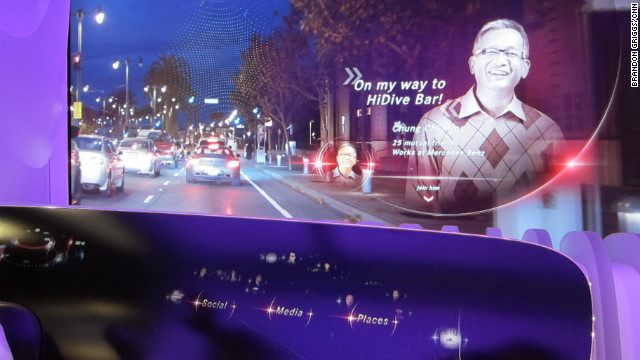During the 2011 Geneva Auto Show (almost a year ago), BMW shared with enthusiasts its Vision ConnectedDrive prototype. "Assisted by sensors integrated into the headlights and taillights, a head-up display on the ConnectedDrive Concept can list information on the road ahead in a 3-dimensional format."
Augmented Reality for drivers was also a feature of last week's Consumer Electronics Show. For example, Pioneer Electronics revealed a display that mounts in place of or below the rear view mirror of any model car to project road information for quick consultation without obscuring the driver's view of the road. The photo below is from the CNN article covering Mercedes-Benz's introduction of what it terms "the Future of Driving.
While everyone acknowledges that a date for commercial release of these technologies has not been set, the direction of research and development in the automotive industry is clear: more sensors, more mobile connected services for the user/driver, more in the driver's field of view. More and better sensors are already available for those who can pay the premium price. Also, in an automobile where miniaturization and low power consumption are not as important as in a smartphone, we can anticipate more advanced and more accurate sensors, including cameras, to appear.
Furthermore, the justification of new gadgets on the basis of driver and road safety appeals to many constituents from the individual driver to the regional and national transportation authorities who have (potentially) fewer troubles with traffic congestion. I haven't read anything about the policies or regulations treating the use of AR in cars, but I wouldn't be surprised if some were introduced.
One of the enabling technologies for these applications is the pico projector. MicroVision is one of the early providers of these technologies, while a neighbor, also in the state of Washington, the Human Photonics Laboratory at University of Washington is another. Other enablers are the variable opacity screen materials (aka Smart glass) which can be manufactured today. And to receive information from the cloud, without interfering with the user's mobile phone service, and perhaps using different protocols, we may have machine-to-machine (M2M) mobile communications. In the case of a high end car, the extra radio (its cost, its weight or power requirements) are not obstacles.
